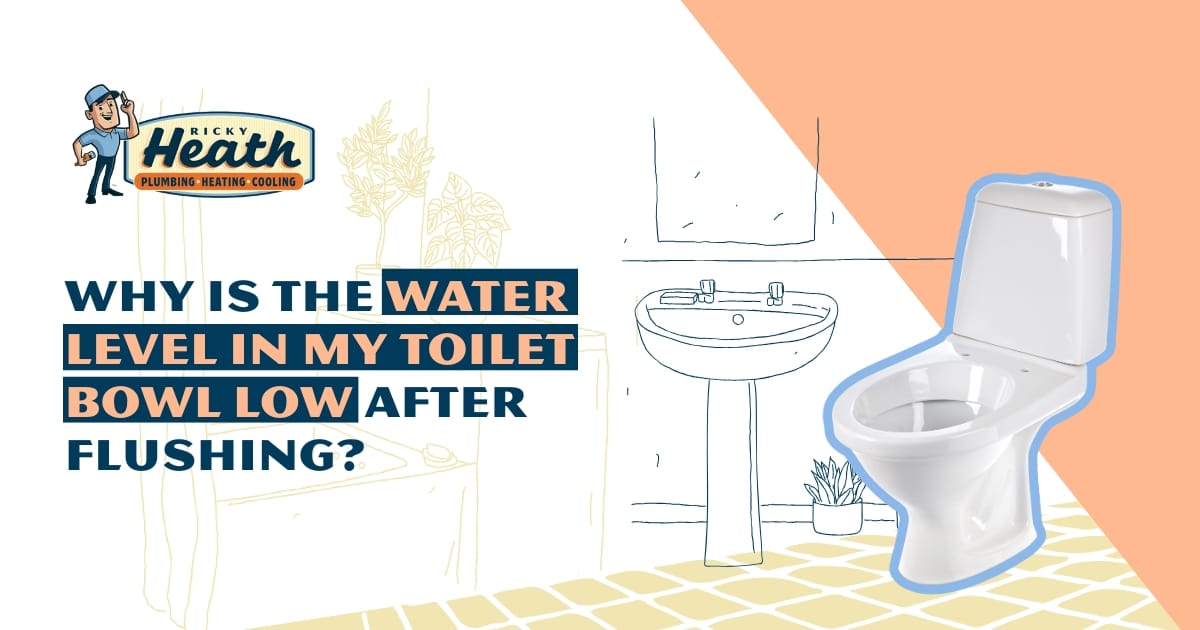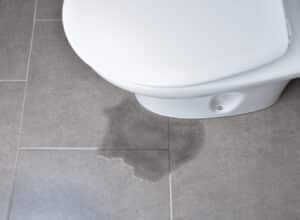
Dealing with a low water level in your toilet bowl after flushing? This is a frustrating problem, and there are a few possible reasons behind it. In this guide, we’ll explain everything you need to know about fixing a low water level in your toilet, including common causes, how to adjust the water level, the impact of this issue on the toilet’s performance, and when to get help from a plumbing professional. Let’s take a look.
Common Causes of Low Toilet Bowl Water Levels
What causes a low water level in a toilet bowl? There are a few likely reasons for this problem:
Drain clogs
When you think of a blocked toilet, you probably think of it overflowing. While this is common, it can also cause a low water level. This is caused by the blockage acting as a siphon, sucking the water out of the bowl and into your pipes. Because the plumbing is obstructed, the water can’t freely flow throughout the toilet’s components, resulting in lower water levels than usual.
Blocked drains are often caused by tree roots, shifting soil, corroded pipes, or unflushable garbage being put down the drain.
Cracked bowl
If your toilet is constantly empty or low on water, there’s a chance that a crack in the bowl is to blame. Sometimes, these cracks are easy to spot, but in other cases, they appear close to the toilet trap. This causes the water to leak into the toilet trap instead of onto your floor, making the leak harder to identify. If you have a cracked bowl, it will need to be replaced by a plumbing professional.
Leaking base

A leak at the base is another common cause for a low toilet water level. This part is meant to be secured to the floor with a few bolts, but these can come loose over the years, allowing the toilet to rock and break the wax seal that attaches it to the floor. Similarly, the water level trouble can be caused by a worn-out wax ring, which is the seal between the bowl and the drain. Both of these seal failures could be the cause of toilet flush problems.
Float adjustment problems
If your toilet bowl water recedes after flushing and doesn’t refill again, it often means there’s an issue with the toilet float. As the name implies, this component floats on the water's surface in your toilet’s cistern, stopping water from flowing into the tank when it’s full. The float arm could be too low if your toilet bowl seems constantly low. Sometimes, you can adjust the toilet float by manually repositioning the ball and arm, but if the issue persists, you’ll need to replace the whole assembly.
Flapper sealing issues

Your flapper is another seal that regulates the amount of water flowing from your tank to your bowl. Over time, it can get worn out and unreliable, either becoming stuck in place or moving unpredictably. A leaky flapper can also cause other issues, such as a ‘sweating toilet.’ Fortunately, this is an easy repair — the flapper simply needs to be replaced.
Vent pipe blockages
The last possible cause of your toilet not refilling properly is a blockage in the vent pipe, usually located on your roof. This component allows air to flow in and out of sewer pipes without allowing toxic sewage gases and unpleasant odors to enter your home. Animal nests, leaves, and other debris can cause blockages in the vent, leading to low water levels and loud gurgling noises from the toilet. A professional will have to get up to your roof and remove the blockage to fix this issue.
Adjusting the Water Level in Your Toilet Bowl
Adjusting your toilet bowl’s water level is relatively straightforward in most cases. Typically, if the tank is filling up to the manufacturer’s specifications, the bowl should be doing the same. If the level in the bowl isn’t right, you can fix it by adjusting either the ball float or the float cup, depending on your toilet’s fill valve type.
Ball float toilet adjustment
A ball float is a floating, usually rubber ball connected to a metal arm in your toilet’s tank. As it moves, it controls the water level in the bowl and tank.
To adjust a ball float, remove the tank lid, then locate the toilet valve shaft on the left side of the tank. On the shaft, there should be a screwhead that controls the float. Using a flathead screwdriver, turn this screw counterclockwise to raise the ball or clockwise to lower it. Do this until the toilet fills to the proper level.
Float cup toilet adjustment
Float cups work similarly to float balls, except they use a plastic cup to control their motion and dictate the toilet’s water level. To adjust it, look for an adjuster on the valve arm. This adjuster can be turned clockwise to lower the float cup assembly or counterclockwise to raise it. Continue tweaking the setting until the water in your toilet bowl is at the right level.
Impact of Low Water Levels on Toilet Performance
Is it a problem when your toilet bowl has a low water level? Limited water affects flushing power, meaning it may not be able to flush everything in the toilet. It can also lead to frequent toilet clogs and unpleasant odors entering the home.
Furthermore, low toilet water levels can create a siphon, which causes even more water to be sucked out into your sewage pipes, making the issue worse (not to mention costing you more on your water bills). Because of this and how low water pressure affects your pipes, it’s important to resolve this common toilet trouble as soon as possible.
When to Seek Professional Help
Some troubleshooting methods for low water levels in your toilet bowl are pretty simple and can safely be attempted on your own with a few basic tools. However, it may be worth contacting the professionals if you’re dealing with a more severe problem than a misaligned float arm. Not only will they be able to diagnose the issue and efficiently fix it, but they can also recommend a preventative maintenance plan to help you avoid further plumbing issues.
In short, if you’re unsure why your toilet water level is low or you don’t feel confident working on plumbing tasks yourself, we suggest contacting professionals, such as the plumbers from Ricky Heath.
Flush Toilet Troubles Away with Ricky Heath
You hope toilets just work. Unfortunately, even a minor issue with its components can lead to issues such as a low water level, creating other plumbing problems the longer it’s left unchecked. If you’re looking for peace of mind with your plumbing fixtures, the team at Ricky Heath is here to help.
With nearly 40 years of experience, countless completed projects in the Macon, GA, area, and a reputation for care, speed, and quality, Ricky Heath is your go-to company for plumbing concerns of any kind. Contact us today to book your service appointment.